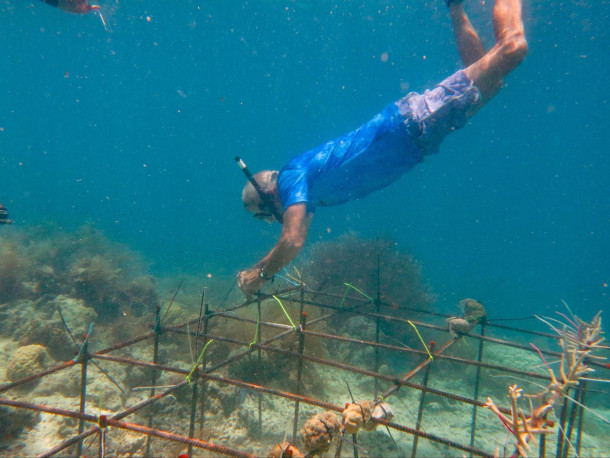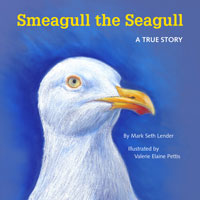Saving Corals Amid Record Bleaching
Air Date: Week of June 6, 2025

Dr. Steve Palumbi samples corals in the country of Palau. His work focuses on testing and growing the number of heat-resistant corals. (Photo: Dan Griffin)
Record-breaking heat in the oceans has led to the most widespread coral bleaching event ever documented, ongoing since January 2023. Bleaching weakens the corals and many end up dying, but others can recover and even thrive amid hotter oceans. Steve Palumbi, a Professor of Biology and Oceans at Stanford University, joins Host Aynsley O’Neill to share how researchers are finding ways to help corals survive and thrive as the oceans warm.
Transcript
DOERING: It’s Living on Earth, I’m Jenni Doering.
O’NEILL: And I’m Aynsley O’Neill.
Record-breaking heat in the oceans is disrupting marine ecosystems around the world in a multitude of ways, including the most widespread coral bleaching event ever documented. The Coral Reef Watch at the National Oceanic and Atmospheric Administration or NOAA tracks coral bleaching and confirmed that the current global bleaching event, which started in January 2023, has impacted almost 84% of the world’s coral reefs. Coral bleaching happens when ocean temperatures are so hot that the stressed-out corals evict their symbiotic algae, turning the corals white and making them look “bleached.” This weakens the corals and many end up dying. But others can recover and even thrive amid hotter oceans. Stanford University Professor of Biology and Oceans Steve Palumbi has been working to find ways to help corals given the extreme heat that now seems commonplace in our world.
PALUMBI: Remember the Taylor Swift song, "Cruel Summer”? Well, we've had two “cruel summers,” 23, 24 you know, what are we going to see in 25? We don't know, but that report from NOAA is a sort of clarion call that “cruel summers” are happening more and more frequently, and it's affecting these corals.
O'NEILL: So apart from the climate crisis, what other factors pose a threat to coral reefs?
PALUMBI: Even before we were really worried about heat waves, corals were suffering from a lot of different other kinds of things. Overfishing causes corals to die. Why? We're not eating the corals. We're eating the fish. The fish play a big role in keeping the coral reef clean, eating algae that overgrows the coral, and so overfishing causes a lot of coral death. Pollution causes coral death, development causes coral death, dynamite fishing. So there's a whole series of things that are typically called local stressors that cause corals to die. And Aynsley, as a consequence of these other things hurting corals, when we're talking about protecting them, restoring them, bringing them back, climate and fixing that is a huge, huge part of it, but it is not the only part. And so actually solving the local stressors and the global stressors is something that always has to go hand in hand.
O'NEILL: Now so we last spoke to you about coral bleaching back in 2013 over a decade ago. How has the situation changed since then? What have we learned about corals in the last decade?
PALUMBI: Well, you know, Aynsley, we've learned a huge amount about corals in the last decade, particularly about bleaching. The tools that we have now available to study bleaching, to look at the genetics, the genomics of it, the physiology, the consequences, the mapping where it happens, satellite tools all the way down to intracellular kinds of probes added enormously to what we know about coral bleaching. But you know, the thing that really strikes me as being the most important is that not all corals are as heat sensitive as others. There are some out there that are pretty heat resistant.
O'NEILL: And so a heat resistant coral, meaning it isn't as affected by these rising temperatures, then?
PALUMBI: Right, I mean, they're not affected the same way in the heat wave. And you can see that in a picture of a bleached coral reef, your eye immediately goes to the white patches, because those are the bleached ones. But my eye goes to the not white patches. My eye goes to the corals that have not bleached. And those have really gone from this incredible mystery over the last decade — How can that happen? — to an incredible asset because we know they're there, and now we're learning more and more about how to use them.
O'NEILL: And as I understand it, there's this sort of potential, and this sort of project about creating even more heat resistant corals. Tell me a little bit about that.
PALUMBI: There's a lot of attention in the coral sort of research and management community about interventions in coral reefs to help them become more heat resistant. And there's a wide set of different tools. You can expose them to a little more warmth, paradoxically, heat them up a little bit, and they get more heat resistant because they get used to that, that warmer temperature, they acclimate. You can maybe swap out the symbionts for a more heat resistant one. People have experimented in putting on pastes of different microbes that might allow them to become more heat resistant. We already know that one of the most important things about that heat resistance is that we don't have to make it all because it's already there. If you use simple tools to go out and just measure the heat resistance of corals, you can find some that are much more heat resistant than others. And then sometimes there are different species. This species is much more heat resistant than this other species. Sometimes it's a different colony in the same species that's much more heat resistant than a colony of the same species from the same place.
O'NEILL: So what would you say is the status of some of these projects? How widespread is the interest in creating heat resistant corals around the world?
PALUMBI: There's a huge interest in creating or finding heat resistant corals around the world. There's efforts, for example, of finding heat resistant corals and using them to set up marine protected areas where there's a lot of them. You can find heat resistant corals and then place them in restoration sites. And so we've been doing a lot of that. We've created a training program called the Coral Futures Academy, led by Courtney Klepac, and that's to train people to do this all around the world. Other people are taking those same corals and breeding them together to try to, like, get the next generation of extra heat resistant ones going at the same time. There's also attempts to try even beginning of genetic engineering to make them along the way. And so all of this set of work, from finding them to breeding them to using them, is all a set of people trying to do the same thing in different ways, which is a great way to try to solve a huge crisis.
O'NEILL: And now I understand that coral reefs actually make up something like less than 1% of the world's ocean, so some might then go, "Well, why are they so important? They're pretty, sure, but why are we working so hard on this?" What would you say in response to that?
PALUMBI: Yeah, the people that live on coral reefs don't say that. And the people who live on coral reefs say, "Can I get my corals back, please?" It's not because they care that much about the corals. I mean, they do. What they want is the fish and corals and coral reefs and coral reef fish are tightly tuned to one another, and for a group of people that uses local reefs as a fishing location for the food for them and their family, their kids, for commerce. They need that in order to survive. Hundreds of millions of people rely on that source of food. They also have this tendency to make rocks. They make rocks in front of the waves, in front of your village or your hotel or your river or your bridge, and so they're like living sea walls that are constantly growing to protect the shoreline. And all these things, food and protection from storms mean that they're hugely valuable as ecosystems to people.
O'NEILL: Now, Steve, let's take this from a climate perspective. You know, even if humanity were to stop releasing all greenhouse gasses tomorrow, global temperatures would keep rising, at least for a little while. So how much of a difference would it mean to coral reefs to cut greenhouse gas emissions sooner rather than later?
PALUMBI: You know, that is an incredibly important question about what it is we're trying to do, because you're totally right, if we stop putting more CO two in the atmosphere today, or in five years, or even by 2050, it's still going to get warmer. The climate crisis is still going to get worse, but eventually it's going to stop and start to get better. And I refer to that as the stopping distance. You know if you're in a car and you're driving along, and you put your foot on the brake, your car is not stopping instantly. It takes a while to bring it to a halt, and so you have to give yourself a space between your car and the car in front, not necessarily in Boston, because I know how you all drive, but in other places, there's this space that you provide. That stopping distance is what we're dealing with now. We have a stopping distance for stopping climate change, but you still got to put on the brakes. You still have to stop. You still have to get that car, get that process to stop, or you'll just run right in to the car in front of you. And that's what we're talking about for reducing CO2 emissions, is putting on the brakes and bringing things to a stop. Now the other part of the question is, all right, how long is that going to take? And then how is what you're doing now going to affect that? And yeah, we have to stop climate change. We have to stop the emissions. But that's not enough because if we did just that and we fixed climate change and the world is dead, we weren't successful. So we have to stop climate change with enough of the world there to be able to grow back from this problem. And that's what we're talking about, saving coral reefs enough now and into the future, so that when we fix the problem, there are coral reefs to grow back.
O'NEILL: Now, solving the climate crisis is obviously a big project, and that's just one aspect of this, though. So what else can be done to save coral reefs on a general level?
PALUMBI: You know, to protect reefs on a general level is really protecting them on a very place based very specific level. What does the reef right here in front of this village need? And what we found going around the world and talking to people about testing heat resistant corals is that people want their reefs to thrive and to be healthy, whether that's for the tourists they bring in or for the fish they bring in, or the protection or the livelihoods or whatever. It's a really amazing natural part of their world, and so helping give them the power to do that is something that, I think is another real aspect of this. We've made the equipment to test corals for heat resistance much cheaper than before. It's just a couple $100, it works in very low infrastructure places you need some power and access to water, but you don't need a marine mab. And we can turn that over to local people doing it. If we can get them jobs to manage reefs with these tools, then they'll begin to build these reefs. And once you start building a reef with heat resistant corals, you're much more dedicated to its survival. And so we're seeing the building of local systems to help these reefs. So lots of the coral world, it's a village-based solution that's really going to work.
O'NEILL: Well, there's a lot of what ifs when we talk about this question. But how optimistic do you feel about the future of coral reefs at this point in time?
PALUMBI: I'm feeling pretty optimistic about it, mostly because I think that as we get closer and closer to 2050, and we have many other ways of energizing our industry and homes besides burning fossil fuels. Do you really want to put $100 worth of gasoline in your car every week, or every two weeks, you know? Or would you rather not? So I think those kind of considerations will really help us, not that it isn't going to be a lot of work, but there's people working on it too. And then I look out on the reefs, and some of them are really in dire shape, like the reefs in Florida, a lot of the ones in the Caribbean, but a lot of them are not yet there. There's diversity, there's fish abundance, there's vibrant growth. If you look in those reefs, there are corals there that are much more heat resistant than others, and so these tools we never had available before, being able to find heat resistant corals, be able to identify them, be able to grow them out, be able to have them create new reefs, are things that we never could do before. And it's not going to solve the problem, but it will certainly help, and it'll get us the next 10 or 20 years, where then we might have corals that are bred for more heat resistance, and they'll be able to go online and etc, etc. So I think we're on a path. I'm encouraged about that, and we've never been on this path before, and so that's what gives me hope.
O'NEILL: Dr. Steve Palumbi is a professor of biology and oceans at Stanford University. Thank you so much for taking the time with us to us today, Steve.
PALUMBI: Hey, Aynsley, this was such a pleasure. Thank you.
Links
Learn about one of Dr. Steve Palumbi’s projects in the Marshall Islands
Read the NOAA report about coral bleaching
Explore more of Steve Palumbi’s work
Listen to Steve Palumbi’s climate-focused parody of Taylor Swift’s “Cruel Summer”
Living on Earth wants to hear from you!
Living on Earth
62 Calef Highway, Suite 212
Lee, NH 03861
Telephone: 617-287-4121
E-mail: comments@loe.org
Newsletter [Click here]
Donate to Living on Earth!
Living on Earth is an independent media program and relies entirely on contributions from listeners and institutions supporting public service. Please donate now to preserve an independent environmental voice.
NewsletterLiving on Earth offers a weekly delivery of the show's rundown to your mailbox. Sign up for our newsletter today!
 Sailors For The Sea: Be the change you want to sea.
Sailors For The Sea: Be the change you want to sea.
 The Grantham Foundation for the Protection of the Environment: Committed to protecting and improving the health of the global environment.
The Grantham Foundation for the Protection of the Environment: Committed to protecting and improving the health of the global environment.
 Contribute to Living on Earth and receive, as our gift to you, an archival print of one of Mark Seth Lender's extraordinary wildlife photographs. Follow the link to see Mark's current collection of photographs.
Contribute to Living on Earth and receive, as our gift to you, an archival print of one of Mark Seth Lender's extraordinary wildlife photographs. Follow the link to see Mark's current collection of photographs.
 Buy a signed copy of Mark Seth Lender's book Smeagull the Seagull & support Living on Earth
Buy a signed copy of Mark Seth Lender's book Smeagull the Seagull & support Living on Earth

